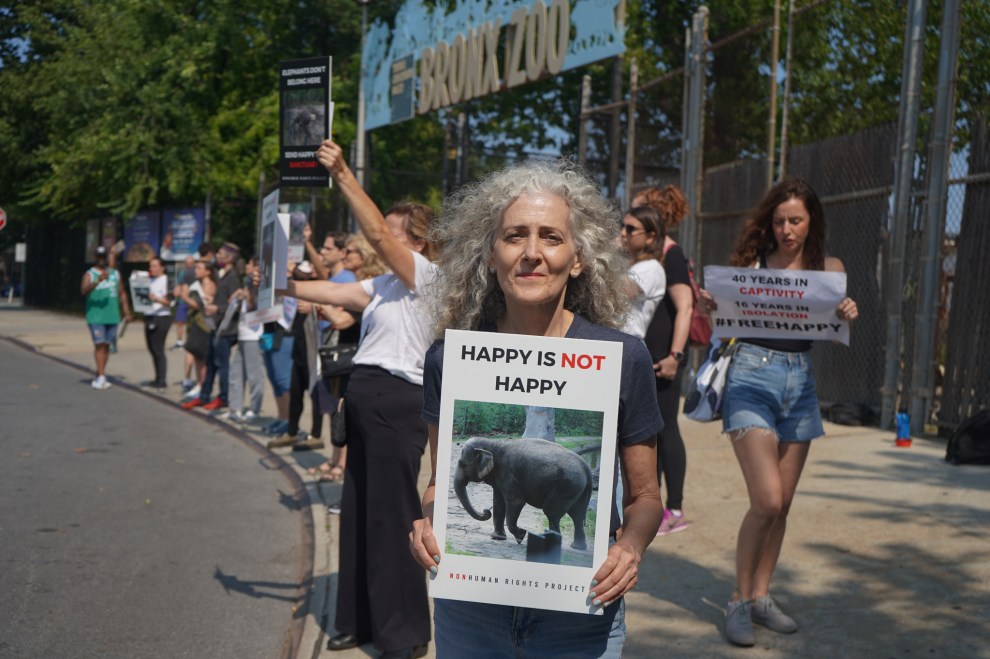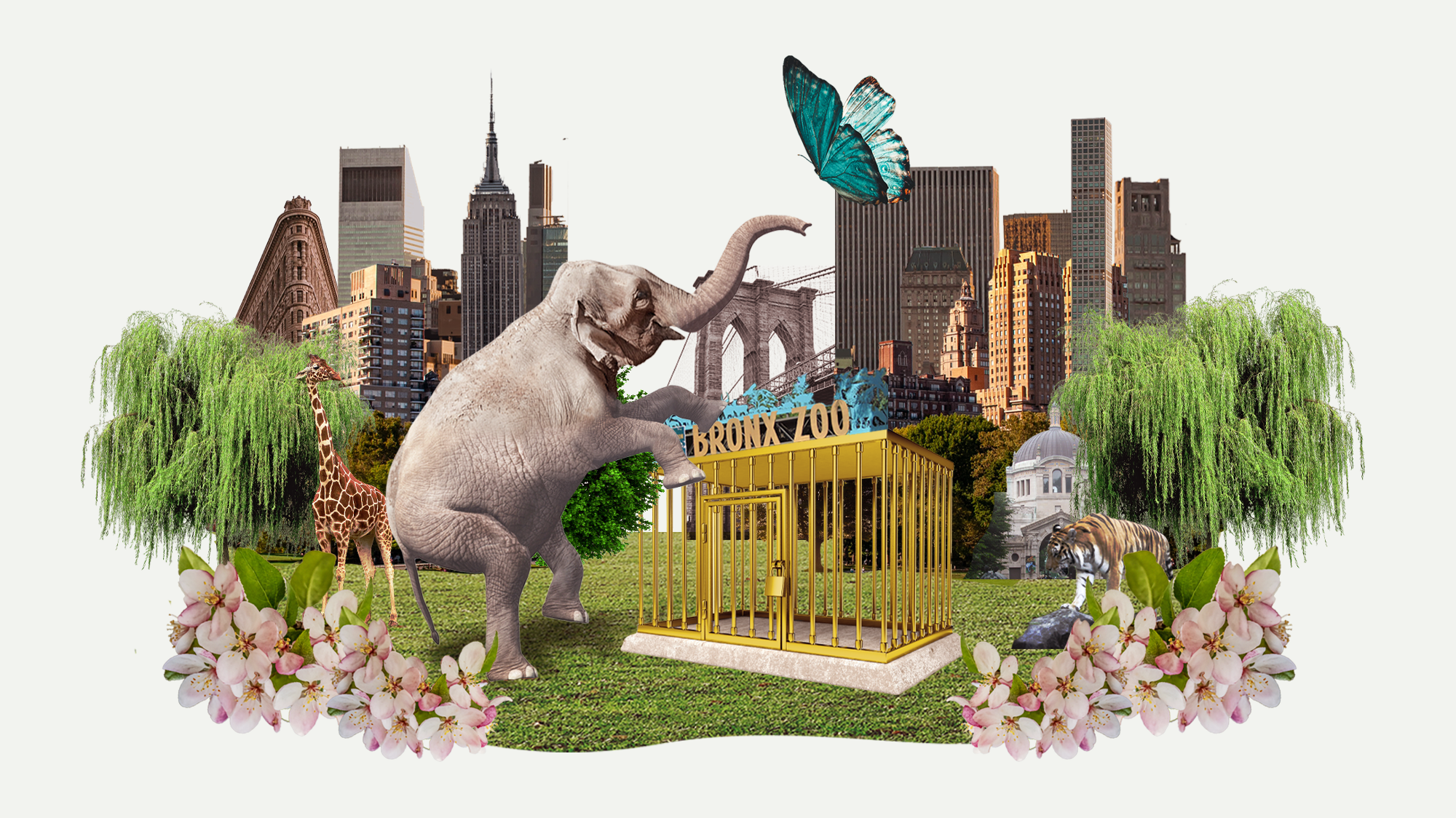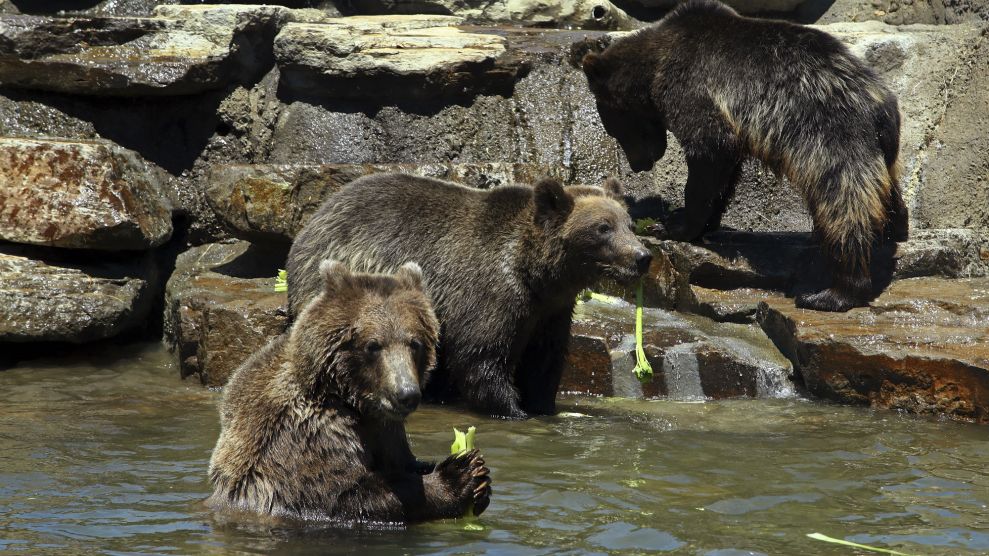The Endangered Species Act has been one of the country’s most valuable environmental tools, but it faces new threats. As the law turns 50, we’re asking whether this “pit bull” of an environmental law, as one expert described it, can survive the challenges of our time—from political attacks to climate shocks. You can read all the stories here.
On a chilly October morning, I embarked on a reporting trip that would have delighted my 7-year-old self: I was off to the Bronx Zoo—the crown jewel zoo not only of New York City but of the nation—to learn about endangered species and possibly meet a Very Important Elephant named Happy. After meandering for an hour and a half, I was rescued by a friendly volunteer decked out in snow leopard gloves and turtle socks. “What’s the quickest route to the elephants?” I asked. She directed me to the Wild Asia Monorail, an elevated 2-mile ride through the park that would eventually put me in front of Happy. “Where are the other endangered species?” I asked. She laughed. Given the climate crisis, she said, “most of the animals here are endangered…everyone is a little vulnerable.”
Climate change is an undeniable threat to wildlife, but not the only one, and the role of zoos in protecting endangered species has proved complicated. The basic selection criteria for endangered and threatened species under the Endangered Species Act—habitat destruction, untempered economic development, disease, predation—have also contributed to a dire situation. The United Nations estimates that about 1 million animal and plant species are at risk of extinction, more than at any other time in human history. More than 2,365 species are listed as currently endangered or threatened under the ESA; 1,667 are native to the United States. Zoos have provided homes to many of them. They’ve also assisted in the implementation of ESA-mandated recovery plans. There are two approaches: one, known as “in situ,” preserves species in their natural habitat, and the other moves them to habitats like zoos that closely replicate the ones in nature.

Bronx Zoo elephant Happy strolls inside the zoo’s Asia Habitat in New York in 2018.
Bebeto Matthews/AP
Indeed, one study in 2018 found that zoos and aquariums were listed as responsible parties for 15 percent of the recovery plans of ESA-listed species. A combination of state agencies, local and tribal governments, and conservation groups have implemented recovery plans that tended to be a combination of population management, or regulating a species’ population size to maximize its chances of survival, habitat restoration, and biodiversity research.
Pursuing conservation in captivity, however, can come with unique challenges, as 30 years of data on breeding animals in captivity reveal. As zoos struggle to maintain genetically diverse populations, some captive-bred animals lose their defining behavioral or physical characteristics, which reduces the likelihood of release and reintroduction. These trends have prompted some in the conservation world to advocate for more investments in the natural habitats of endangered species. But zoos like the one in the Bronx, which have tried to replicate animals’ original habitat and support local conservation efforts in more than 50 countries, see themselves as providing the bridge between in-situ and ex-situ conservation efforts. Add animal rights advocates to the mix, however, and a string of high-profile animal deaths in captivity (remember Harambe the gorilla?), and a heated decades-long debate emerges concerning what role, if any, zoos can play in the effort to protect endangered species.
During a beautiful monorail ride through “Wild Asia,” we watched a group of Indian bison grazing in an open field, two Indian rhinos covered in mud engaging in a standoff, and a Malayan tiger slowly walking through a forest-like exhibit. And then it was time for the elephants. When Happy finally appeared, a mile away and tucked in the far corner of large, oasis-like exhibit, it was impossible to see her face; only her backside was visible. Still, elephant butts have their singular appeal, and delighted oohs and aahs filled the train as we watched her ears flap and her tail swish. Our guide begged us to remain in our seats as she shared Happy’s vital statistics: Weight: approximately 10,000 pounds; diet over 200 pounds of hay a day and more than 60 gallons of water. Habitat: a large tree-sized back scratcher and a nice large pool.
Our guide failed to mention another important fact about Happy: she was the main plaintiff in a landmark animal rights case, in which the fundamental question of animals in captivity was addressed. Five years ago, the Nonhuman Rights Project (NhRP), an animal advocacy organization, brought a case on Happy’s behalf, arguing that Happy, who was born in the wild and became the first elephant to recognize her own reflection in 2006, was unjustly imprisoned. The case reached the State of New York Court of Appeals and led to another first in 2022 when Happy became the first elephant to have habeas corpus hearings. Mistreatment or abuse by the zoo was never suggested, instead, the question was whether a “cognitively complex and autonomous nonhuman” should be “recognized as a legal person with the right to bodily liberty.” Last June, the court’s answer was unambiguous. “While no one disputes the impressive capabilities of elephants,” wrote Chief Judge Janet DiFiore, “we reject petitioner’s arguments that it is entitled to seek the remedy of habeas corpus on Happy’s behalf.” Habeas corpus, the judge maintained, is a vehicle for protecting the rights of human beings, not nonhuman animals.
Happy’s fate notwithstanding, few places are better suited to exploring the relationship between zoos and endangered species than the Bronx Zoo. Founded in 1899 as the New York Zoological Park, the zoo was heralded as a victory for animals and mankind alike, “a menagerie” of “animals, birds, and reptiles from every quarter of the earth,” according to local reporters who attended the opening ceremonies. More than a century later, the 260 acres of sprawling vegetation is home to more than 10,000 animals and 700 species, many of which are endangered. It is also the headquarters of the Wildlife Conservation Society (WCS), one of the oldest conservation nonprofits in the country. WCS is based in the US and oversees all of New York City’s zoos and aquariums as well as global conservation programs in 50 countries. They are a central player in advancing international climate agendas, including the UN’s 30×30 commitment, which seeks to protect at least 30 percent of the planet’s land and water by 2030.

A protest was held at the Bronx Zoo in 2022, to raise awareness about the plight of elephants kept in captivity and to call upon the zoo to free Happy who has been in solitary confinement for 16 years.
Nancy Siesel / ZUMA
The Bronx Zoo is overseen by WSC, but it also reports to the Association for Zoos and Aquariums (AZA). The ties between these three groups run deep: the head of the Bronx Zoo is also the Executive Vice President of WSC and the chair of the AZA Board of Directors. Since its founding in 1924, the organization has been a major player in both zoo conservation and the implementation of the Endangered Species Act (ESA). “We’ve got quite a mess on our hands in terms of the future of wildlife,” said Jamie Rappaport Clarke, president of Defenders of Wildlife, a national conservation nonprofit. “AZA zoos and aquariums are the cavalry.”
Chances are if you visited a major zoo or aquarium in the last few years, it was one in which the AZA was involved. The nonprofit accredits 237 zoos and aquariums in 13 countries. The US is home to 213 of those facilities, but a few are in Canada, Mexico, Singapore, and even the United Arab Emirates. Of the more than 8,600 species housed in AZA facilities, 800 are categorized as endangered or vulnerable by the International Union for the Conservation of Nature—a global conservation authority, which positions the nonprofit to play a key role in the implementation of the Endangered Species Act.
In 2019, AZA zoos and aquariums reported investing $50 million annually in more than 200 species listed as threatened or endangered under the ESA. They also launched SAFE (Saving Animals from Extinction), an initiative that operates individualized conservation programs, from expanding anti-poaching efforts in Uganda to protecting turtle nesting sites in Costa Rica, for 39 species, most of which are listed under the Endangered Species Act. “We’re teaming up our members to work together to save species from African vultures to black-footed ferrets to red wolves,” says AZA president Dan Ashe. “We’re trying to harness the collective power of our membership because we’re likely living in the middle of a sixth mass extinction. If we’re going to be successful, we need more conservation at scale.”
In some ways, the Bronx Zoo has been doing this type of conservation work since its founding in 1899. The zoo’s first director, William Hornaday—a racist zoologist who put a young Central African man on display in 1906—sent herds of bison to the Oklahoma in the early 20th century, a move credited with helping to bring the species back after being hunted to the brink of extinction. The zoo commemorated that history in 2022 by sending six bison to join a herd of nearly 200 in the Osage Nation in Oklahoma. The exchange will help bolster the genetic diversity of the Osage’s existing herd, ensuring the continuation of what zoo officials call “one of the most successful conservation programs in US history.” In addition to the American bison, the Bronx Zoo’s staff of nearly 4,000 is credited with saving the wild Tanzania Kihansi spray toads, which had been declared extinct in the wild in 2009. They have successfully bred the blue iguana, Roti Island turtles, and snow leopards, and helped “delist” or remove animals like bald eagles from the ESA’s roster of endangered and threatened species.
But not all endangered species flourish in captivity. Elephants like Happy, for instance, rarely appear in zoo success stories. In fact, over the last two decades, zoos have found themselves in the uncomfortable position of being cast more as threats to elephant survival, more than assets. The dangers begin at birth. Nearly 40 percent of elephants born in zoos die, nearly triple the rate of those in the wild. Adulthood is no less hazardous. One 2012 Seattle Times investigation into 300 elephant fatalities at accredited zoos in the last 50 years found that at least 41 percent of the deaths occurred before they were 23 years old, or “more than a quarter of a century before their expected life spans of 50 to 60 years.” In most cases, the deaths were linked to conditions of captivity. In the wild, elephants are highly active, sometimes traveling up to 50 miles a day, and live in large multi-generational herds. In zoos, elephants often develop depression, obesity, and arthritis. Their highly developed brains deteriorate, manifesting in signs of psychological distress like rocking or swaying. “I think the most damning thing is that they just die,” says Emma Marris, an environmental writer and author of Wild Souls: Freedom and Flourishing in the Non-Human World. “Some animals live longer in captivity because their predators aren’t there, and they get fed every day…but elephants aren’t among them.”
These diminished lifespans, and in some cases dubious justifications for captivity, have prompted major zoos, including those in Seattle, San Francisco, and Chicago, to close or phase out their elephant exhibits. The Bronx Zoo joined the wave in 2006, pledging to stop adding to their elephant herd after a string of deaths. Only Happy and Patty remain, and they live separately due to past violence between them.
Elephants are far from the only creatures not living their best lives at zoos. “All of the animals that have the worst outcomes at the zoo are the most popular animals at the zoo,” says Marris. “Elephants, polar bears, tigers, apes. They’re the ones that tend to be most prone to stereotyped behaviors where they rock and pull out their own hair and eat their own shit. If you took all the animals that are not happy out of zoos, you’d end up with newts and ground squirrels.”
On a population level, mammals of all sizes, from the North American black-footed ferret to the Asian rhino, can be negatively impacted by captivity, which “imposes rapid yet often irreversible changes to the brain, cognition, and behavior,” wrote a team of biologists and zoologists in a 2023 study. The cognitive results of this “captivity effect” rarely factor into ESA recovery plans, but they can alter an animal’s long-term biological and psychological profile, exposing them to a host of new vulnerabilities.
When I spoke to Dan Ashe, head of the Association for Zoos and Aquariums (AZA), about Happy and the costs of captivity, he referred to the noted chimpanzee specialist and conservationist Jane Goodall. “Jane taught me that you have to think of animals as part of a population, but also as individuals. Happy needs to be thought of individually, not as a wild free-ranging elephant.” To Ashe, because Happy has lived most of her life in captivity, it’s what she knows and likely where she’s happiest. And after all, as he reminded me, surviving in the real world is no picnic. “We tend to romanticize life in the wild, but if you’ve seen an elephant who’s lost its trunk or foot to a snare, or elephants that have been poached and butchered for their tusks. Life in nature is certainly not idyllic.” Ashe has seen this reality up close as a former staffer at the US Fish and Wildlife Service working domestically to curb the commercial sale of ivory. For Ashe, WSC and the Bronx Zoo are models of what modern zoos and aquariums should be. “Not just places you can go and see animals,” he says, “but where you can learn about them and support their conservation.”
While Happy lives out her remaining days on an enviable amount of New York City square footage, the AZA is forging ahead with other ambitious conservation plans. AZA’s SAFE program has surpassed its 2022 projections, investing a whopping $1.1 billion in conservation spending. By 2027, the goal is to turn $1.1 billion into $2.5 billion, increase the number of SAFE species from 33 to 50, and ensure participation from 100 percent of AZA members. Animals under the SAFE umbrella, including Asian elephants like Happy, American red wolves, and North American Songbirds will benefit from the combined concentration of zoologists and conservationists from 197 AZA-accredited zoos, including the Bronx Zoo, which is currently co-leading the Gorilla SAFE program. Meanwhile, AZA zoos will continue to feel the pressure from animal rights groups like the Nonhuman Rights Project (NhRP), which, encouraged by two blistering dissents in Happy’s case, will soon be filing more cases on behalf of captive elephants and expanding their client base to include chimpanzees and orcas.
Whether or not they succeed, the future of zoo captivity will continue to play out in court hearings and in cities like Ojai, California, that recently banned elephant captivity. It will also play out in science labs, classrooms, and wildlife reserves. And, of course, in zoos, where over 200 million visitors, many of them children and families, gather to appreciate the wonders of nature and animals. Whether Happy’s personhood crusade shifts that beloved tradition remains to be seen, but once the door—or cage—is open, it’s hard to close it. Judge Rowan D. Wilson, the first Black chief judge on the New York State Court of Appeals, might have said it best in his dissent when he called on the court to uphold Happy’s right to petition for bodily liberty “[N]ot just because she is a wild animal who is not meant to be caged and displayed, but because the rights we confer on others define who we are as a society.”













